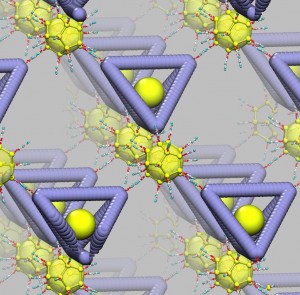Starr’s Nanoparticle Research Published in Science

Professor Francis Starr, graduate student Hamad Emamy and collaborators from the Brookhaven National Lab have co-authored a paper titled “Diamond Family of Nanoparticle Superlattices” published in the prestigious journal Science on Feb. 5. Starr is professor of physics and director of the College of Integrative Sciences.
Their work proposed a solution to a decades-long challenge to self-assemble a diamond-structured lattice at will from nanoscale particles.
“Such a diamond-lattice structure has long been sought after due to its potential applications as a light controlling device, including optical transistors, color-changing materials, and optical — as opposed to electronic — computing,” Starr said.
To solve this challenge, the team utilized the specific binding properties of DNA as a tool for materials science. Specifically, they created nanoscale “atoms” that consist of 15 nanometer gold nanoparticles coated with many single-stranded DNA. The single-stranded DNA act like binding arms to connect nanoparticle/DNA “atoms” by forming double-stranded DNA links, and analogue of traditional chemical bonds between atoms. By appropriate selection of the sequence and orientation of these DNA links, the nanoparticles will spontaneously arrange themselves into the desired structure.
“This self-assembly approach not only allows for highly specific order, but also offers the potential for tremendous savings in the cost of materials production, as compared to traditional methods used in the semi-conductor industry,” Starr explained.
Emamy, a graduate student in Starr’s lab, carried out numerical simulations that helped to develop the approach and explain how to stabilize the structure. Collaborators at Brookhaven experimentally synthesized and verified the structure and properties. The effort, Starr said, represented an ideal collaboration between experiments, theory and computation.

